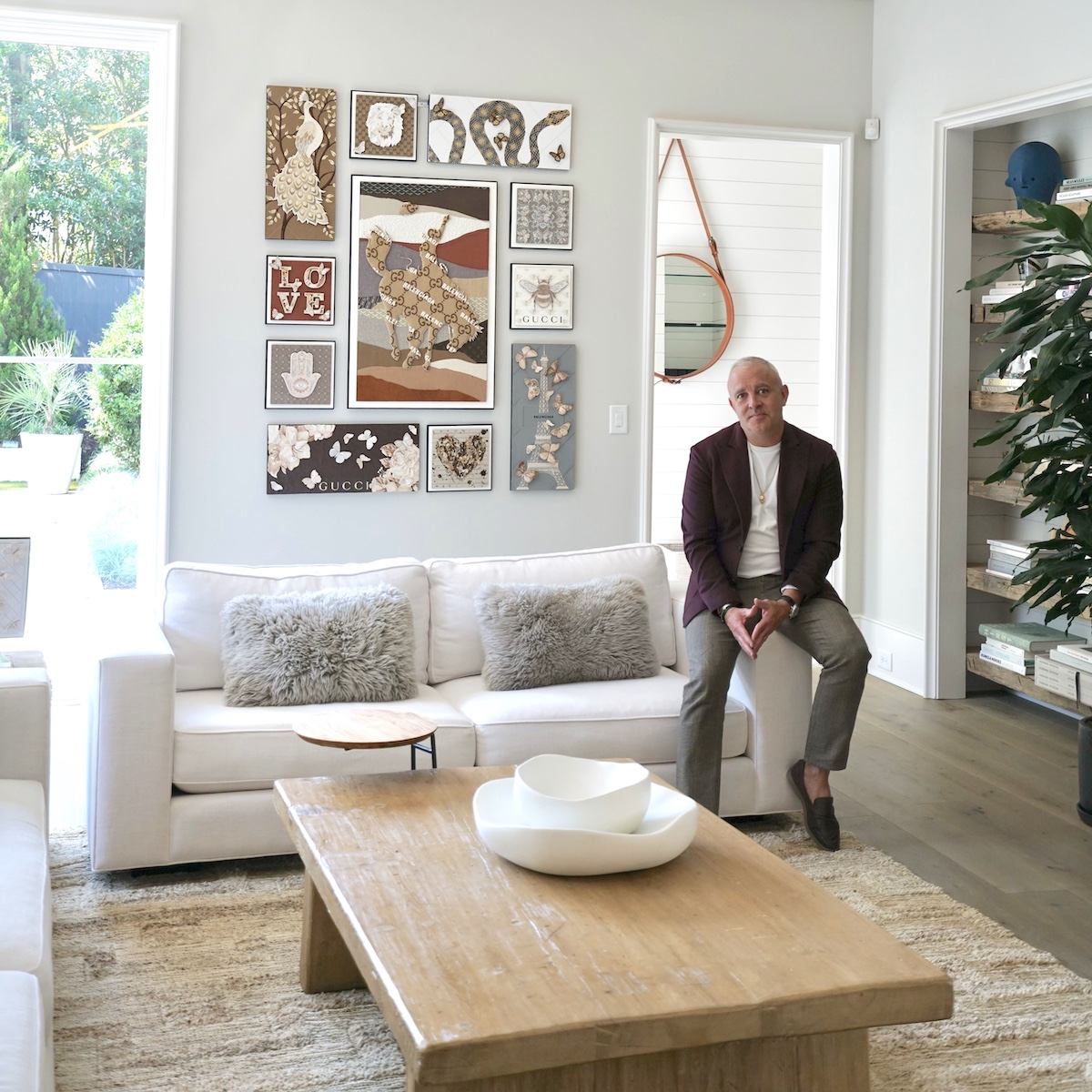For example, at the 2022 FLOWER magazine Atlanta Showhouse, Charlotte designer Lisa Mende had a vision. She was tasked with decorating one of the home’s bedrooms, and she wanted to extend the textile she’d chosen from Thibaut from the wall onto the headboard. But she wanted more than a standard fabric-covered headboard design, so Mende reached out to an artist she’s long admired and whose work she collects: Stephen Wilson.

Photo courtesy of Stephen Wilson Studio
Based in digitalized embroidery, Wilson’s work, both commercial and personal, synthesizes elements of couture, conservation, style, and pop culture to create objects that are as beautiful as they are thought-provoking. He’s exhibited around the world, created original art that he sells at the High Point furniture market, and is no novice when it comes to collaboration.
But his medium brings with it a set of potential hurdles. With embroidery, Wilson chooses among 5,000 spools of thread. Selecting colors for a custom design is much more complicated than just picking a single shade. “Choosing a thread can actually be a laborious process. The threads you choose do not always translate to what you have in your head,” he says. “And then there are the thicknesses that are just as important—silk, polyester, wool, and flat treads—that add another layer of complexity,” he says.
Mende’s vision was not about reproducing the Thibaut fabric. She was looking for an artistic interpretation that evoked the fabric but also included Wilson’s deft, original touch with embroidery—a more three-dimensional approach to the textile. And drawing from her own background in fashion, she wanted color and personality, a dynamic expression of both of their passions.

Photo by Emily Followill
Headboard with embroidery by Stephen Wilson, designed for Lisa Mende's bedroom in the FLOWER Magazine Atlanta Showhouse.
After their first meeting, Wilson presented Mende with a mockup that reflected her description. But when she got to the studio and saw the first design, she hesitated. His embroidered design veered from the initial mockup, more whimsical and airy. It was great looking but not as spot on as what he had initially proposed. But then he explained to her more about the process. “There was a learning curve for me, certainly,” says Mende with a laugh. To do exactly what Mende wanted would require around 3-million stitches, an impossible feat in terms of time, cost, and practicality.
Artist and designer talked it out and altered the design with “two to three different colorations,” says Mende. The headboard changed from Wilson’s first mockup, and it hits it out of the park in terms of relating to the fabric-covered walls and contributing to a beguiling space. “Stephen created the perfect headboard that is the crowning jewel in the room,” says Mende. “It reflects the wall mural and flowers in the paper. Even though it took a few iterations to get there, he understood my vision.”

The Fantasy Tree is the largest piece that Stephen has created to date.The installation is comprised of seven panels that are each 12”x40” and together when hung, measure 96”x40”. The Fantasy Tree was inspired by vintage De Gournay wallpaper. Photo courtesy of Stephen Wilson Studio
Wilson’s current work is the result of more than 30 years of practical application. It’s a process, one that does not involve him toiling away with a needle and thread as his eyes strain to exact a meticulous design. Rather, he has a large studio in Charlotte, with designers and operators who produce commissions. “I draw everything on a large screen, using a stylus, then send it to the machines,” he says. “Hand embroidery uses thicker threads, and it could never do the more complicated stitches or embroider on cardboard or other media, which is part of my process.”
Wilson started out at age 23 in his hometown of Hoboken, New Jersey, creating commissions with his mother doing embroidery for businesses. Over time, he got into licensing projects for sports teams and in the fashion industry, always adding to his machines and his artistic and technical proficiency. But in 2004, he moved to Charlotte. “My sister lived here, and I needed more space. Charlotte has a history of textile mills and producing fabric.”
Since then, his commissioned work has evolved with his individual pieces, which he has exhibited at major art shows, such as Art Basel in Miami. He’s shown pieces in exhibitions such as the New Gallery of Modern Art in Charlotte and all over the world and is in major corporate art collections and museums, like the National Gallery of Art in Sofia, Bulgaria. And he’s contributed to showhouses like Kips Bay and in the Hamptons.
His most recent project stems from his commission with Lisa Mende. In addition to his booth at High Point, Wilson has partnered with Jonathan Charles, the maker of the showhouse headboard, to produce 8 installations and 120 pieces of art for the fall market.
Wilson is remarkably calm, considering the constant rush of activity and deadlines swirling around him. Chalk it up to experience and passion for his product, as well as to his commitment to the impact his work will have. “My personal creative pieces deconstruct beautiful couture work—Hermès or Pucci scarves, Tiffany boxes, purses—and then we re-create a piece of art that presents the piece in a new way for the wall or other display,” he says. “It’s a way to capture and preserve beauty so it’s not tucked away in a drawer or closet to be brought out once a year.” Like the headboard and his collaboration with Lisa Mende, Wilson manipulates mind and machine to create the unique and enduring.
By Frances MacDougall
See more from Lisa Mende.
Learn more about the FLOWER magazine Atlanta Showhouse.



